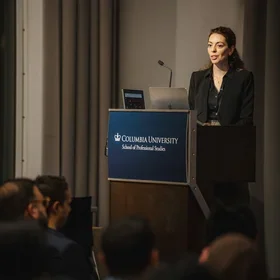By Celia Kapsomera, Part-Time Lecturer in the Enterprise Risk Management Program, School of Professional Studies
In today’s dynamic and interconnected world, staying informed about current events is critical for business students, especially for those focused on strategic risk management. Understanding the global economic and business environment, political climate, technological advancements, and social trends provides invaluable context that enhances the practical application of theoretical knowledge.
Frequently reading the press and keeping up with developing news enables students to identify emerging risks, assess potential impacts, and learn to craft effective mitigation strategies. In the context of the M.S. in Enterprise Risk Management (ERM) program at the School of Professional Studies at Columbia, incorporating current events articles into the curriculum is an important tool we use to bridge the gap between academic theory and practice in understanding risk in real-world situations.
I would argue that awareness of current events helps not only by applying theory to practice and thus building competence in strategic risk management but also by building critical skills for use in the working world.
Let me explain: Strategic risk management is about identifying, assessing, and economically managing major risks that could affect a company’s long-term success. These risks (and potential opportunities) could stem from changes in regulation, competitive forces, business relationships, geopolitical events, reactions from a company’s stakeholders, or even societal shifts. In the Strategic Risk Management course, students are taught to analyze and mitigate these risks using various frameworks and methods. In order to truly excel in this field, however, it is essential to go beyond theoretical knowledge.
When students regularly engage with current events, they sharpen their abilities to spot risks as they are developing. News articles often serve as case studies of how companies either effectively mitigate risks or fail to do so, offering rich learning opportunities. For instance, reading about a major governance failure in a global financial institution helps to illustrate the abstract concept of governance risk and facilitate the students’ understanding of its detrimental impact on financial results and reputation. Similarly, news about trade wars or economic sanctions are examples of the destabilizing effects on business due to political risk. News about partnerships illustrates how companies are attempting to grasp opportunities or mitigate risks, often creating different types of risk for themselves.
Discussing current events also allows students to see how interconnected risks are today—how a geopolitical crisis in one region can lead to supply chain disruptions, financial instability, or reputational damage elsewhere. This awareness builds critical competencies that are vital for strategic risk management professionals who need to assess the full spectrum of risks affecting a company’s strategic objectives.
Incorporating current events into the Strategic Risk Management course is not only a way to keep the classroom content fresh and relevant, but also a practical tool to enhance critical thinking. Students are tasked with analyzing emerging risks and proposing solutions based on the theories they have learned. This application of theory to practice helps develop the competency to employ risk management techniques in practical, real-world scenarios.
When students use current events as case studies, they engage in analysis, moving from strategy to risk identification to proposing strategic mitigations. This practice enhances their ability to evaluate a company’s situation holistically, considering a host of internal and external factors. It also trains them to think quickly in order to keep up with many of the risks companies face, which tend to evolve rapidly. By studying current news stories, students gain hands-on experience in anticipating potential threats, assessing their likelihood, and evaluating the best course of action to mitigate them. When reading about the impact of the pandemic on global supply chains, for example, students were asked to critically assess strategic risks and recommend contingency plans. News stories thus become exercises for students to develop their ability to make informed decisions, help solve complex problems, and communicate these solutions effectively. These skills are essential for engaging in the practice of risk management.
Ultimately, the goal of integrating current events into the Strategic Risk Management course is to prepare students to apply their knowledge in the real world. Employers expect graduates to demonstrate an ability to think strategically, analyze complex situations, and communicate their assessments clearly using the frameworks they learn when and where these tools are appropriate. For students to cultivate these skills, regular engagement in discussions of relevant current events offers a great opportunity to evaluate new information, learn to anticipate the broader impact of risks on industries, regions and countries, draw conclusions, and articulate actionable ideas for possible mitigation.
About the Course
Strategic Risk Management, one of four electives offered by the Enterprise Risk Management program, reviews all types of strategic risks, and includes case studies, research, and common mitigation techniques.
About the Program
The Master of Science in Enterprise Risk Management (ERM) program at Columbia University prepares graduates to inform better risk-reward decisions by providing a complete, robust, and integrated picture of both upside and downside volatility across an entire enterprise.
Fall 2025 application deadlines for the M.S. in Enterprise Risk Management program are March 15, 2025 for applicants with international documents, and May 1, 2025 for the final deadline. Learn more here.



